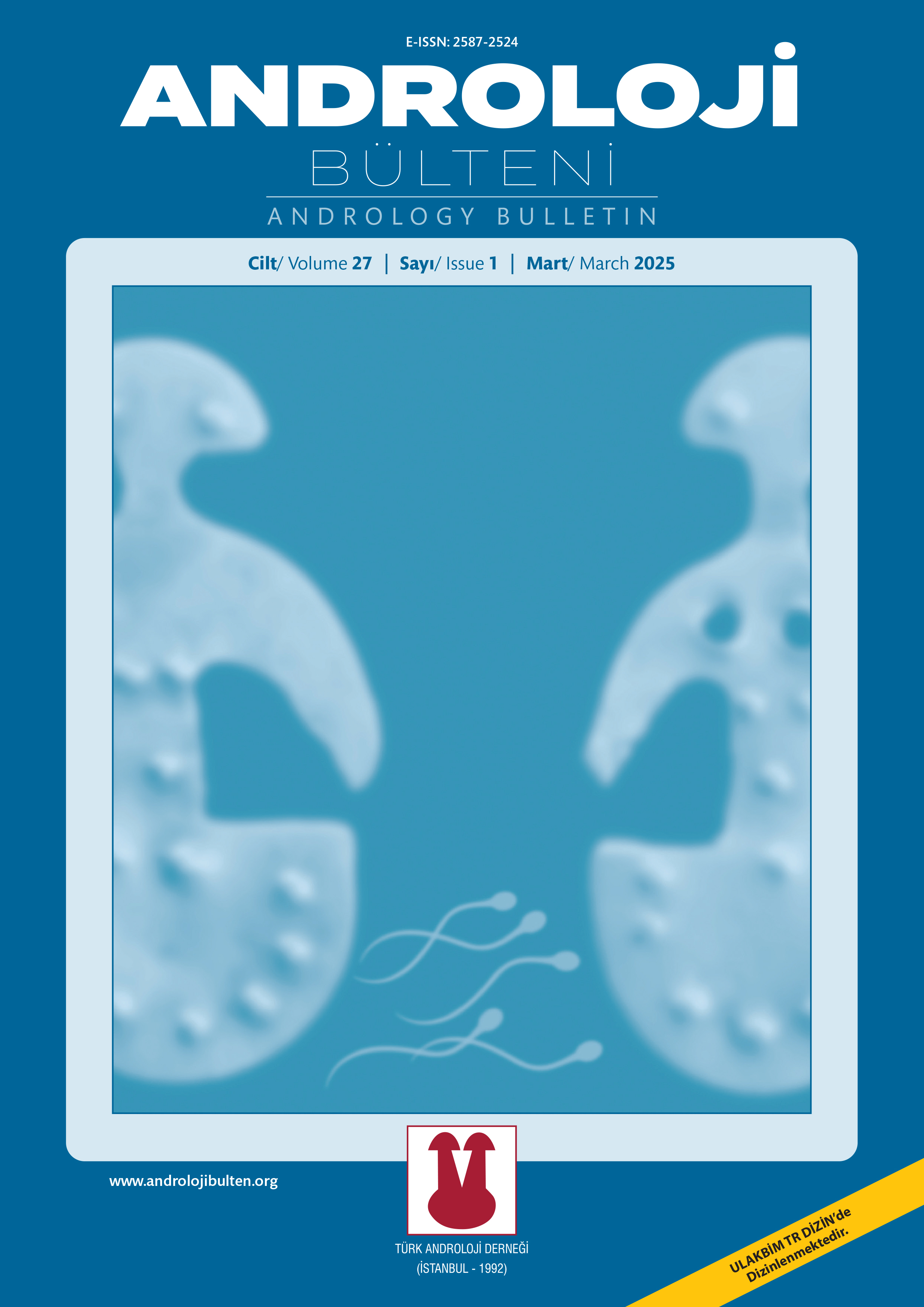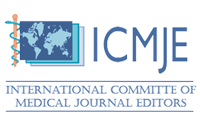INDEXES

Content of this journal is licensed under a Creative Commons Attribution-NonCommercial 4.0 International License.
Volume: 26 Issue: 3 - 2024
| 1. | Cover Page I |
| 2. | Reviewers Pages II - III |
| 3. | From the President Page IV |
| 4. | From the Editor Page V |
| 5. | Contents Page VI |
| ORIGINAL ARTICLE | |
| 6. | Assessment of depression and anxiety levels in the patients with premature ejaculation Süleyman Sağır, Şule Allahverdi, Müslüm Ergün, Kübra Sezer Katar doi: 10.24898/tandro.2024.38039 Pages 163 - 166 OBJECTIVE: Premature ejaculation patients often present to the hospital with poor psychological conditions. The aim of this study is to evaluate the levels of depression and anxiety in patients presenting with premature ejaculation complaints. MATRERIAL and METHODS: The study included only patients with lifelong premature ejaculation (PE) and acquired PE. A total of 80 patients were included in this study. After recording demographic data such as age, height, weight, body mass index (BMI), occupation, etc., patients who met the inclusion criteria were administered the Beck Depression Inventory (BDI) and Hospital Anxiety and Depression Scale (HADS) questionnaires to assess the severity of depression and anxiety. RESULTS: The premature ejaculation evaluation questionnaire scores, Beck Depression Inventory (BDI), and Hospital Anxiety and Depression Scale (HADS) scores were found to be significantly higher in individuals with premature ejaculation duration of less than 30 seconds compared to those with a duration of over 30 seconds (p<0.05). Additionally, correlation analyses showed that as the premature ejaculation questionnaire score increased, both the BDI score (r=0.775) and HADS score (r=0.882) also increased. CONCLUSION: In male patients, an increase in the severity of premature ejaculation is associated with an increase in depression and anxiety levels. Therefore, a multidisciplinary approach should be exhibited in the evaluation and treatment of patients. |
| 7. | Predictive value of hematologic parameters in the differential diagnosis of testicular torsion and epididymo-orchitis Metin Yığman, Berk Yasin Ekenci, Hüseyin Mert Durak, Adem Sancı doi: 10.24898/tandro.2024.20053 Pages 167 - 172 OBJECTIVE: Testicular torsion (TT) is a urologic emergency that may result in organ loss. The most common differential diagnosis is epididymo-orchitis (EO). The aim of this study was to evaluate the usefulness of hematologic parameters and inflammatory markers in the differential diagnosis of TT and EO. MATRERIAL and METHODS: Data obtained from complete blood counts of patients admitted to the emergency department with acute scrotum and diagnosed with TT and EO between January 2015–2024 were retrospectively evaluated. Demographic characteristics of the patients and the parameters in the complete blood counts at the time of presentation were recorded. Neutrophil/lymphocyte ratio (NLR), platelet/lymphocyte ratio (PLR) and monocyte/eosinophil ratio (MER) were calculated. The groups were compared in terms of age, hematologic parameters, NLR, PLR and MER. Receiver operating characteristic and areas under the curve of the parameters found significant were determined. Univariate and multiple logistic regression analysis were used to determine the risk factors for differential diagnosis. RESULTS: A total of 149 patients were included in the study. The TT group consisted of 79 patients and the EO group consisted of 70 patients. The median age of all patients was 23 years, the median age in the TT group was 20 years, and the median age in the EO group was 23 years. There was a statistically significant difference between the two groups in terms of age, lymphocyte count, monocyte count, eosinophil count, mean platelet volume (MPV), NLR and PLR (p<0.05). In multiple logistic regression analysis, only MPV value ≤9.35 was found to be an important predictive factor for the differential diagnosis of TT and EO. CONCLUSION: MPV seems to be a useful parameter in the differential diagnosis of TT and EO. In this regard, prospective, multicenter studies as well as meta-analyses with larger sample sizes should be included in guideline recommendations with their contribution to the literature. |
| 8. | Evaluation of ChatGPT’s performance in answering questions about female lower urinary tract symptoms Abuzer Öztürk, İsmail Emre Ergin doi: 10.24898/tandro.2024.53486 Pages 173 - 178 OBJECTIVE: ChatGPT is a language model developed by OpenAI. As a language model, ChatGPT can be used for various natural language processing tasks, such as answering questions, providing information, engaging in conversations, and more. We aimed to evaluate ChatGPT’s suitability to accurately inform patients and medical students by analyzing the reliability and accuracy of lower urinary tract symptoms (LUTS) information in women. MATRERIAL and METHODS: Systematically organized frequently asked questions from urology association websites, hospitals, and social media platforms regarding lower urinary tract symptoms (LUTS) in women, along with questions compiled from European Association of Urology (EAU) recommendations, were analyzed. All questions were systematically submitted to ChatGPT 3.5 and 4.0 versions. Two expert urologists independently evaluated the data and answers to the questions and assigned scores from 1 to 4 to each answer. RESULTS: A hundred and three frequently asked questions and 36 questions compiled from EAU guideline recommendations regarding LUTS in women were included in the study. 83.50% of the frequently asked questions (85.44% for version 4.0) and 80.56% of the questions compiled from EAU recommendations (80.56% for version 4.0) were rated as ‘completely correct’ (Grade 1). The rate of completely incorrect answers to the questions (Grade 4) was 0.97% in the frequently asked questions group (0.97% for version 4.0) and 2.78% in the guide-based questions group (2.78% for version 4.0). The success rate of both versions in answering questions was found to be close to each other. CONCLUSION: ChatGPT provided acceptable responses to the posed questions. Despite its limitations, we believe that utilizing this continuously evolving platform under the guidance of urologists in urology clinics will contribute to the diagnosis and treatment processes for patients and their families. |
| 9. | Does the genital self-image of pregnant women affect their sexual satisfaction?: A cross-sectional study Nazlı Baltacı, Rabia Atilla, Özlem Doğan Yüksekol doi: 10.24898/tandro.2024.54289 Pages 179 - 184 OBJECTIVE: To determine the effect of genital self-image on sexual satisfaction in pregnant women. MATRERIAL and METHODS: In this cross-sectional and descriptive study, 513 pregnant women who applied to the pregnancy follow-up outpatient clinics of a hospital in eastern Türkiye between June 2022 and January 2023 were included. Data were collected by face-to-face interviews with the pregnant women who were eligible to participate in the study using the “Pregnant Information Form,” “Female Genital Self-Image Scale (FGSI),” and “Sexual Satisfaction Scale for Women (SSS-W).” Data were analysed by descriptive statistics, Pearson correlation analysis and linear regression analysis. RESULTS: The mean age of the pregnant women was 30.88±4.52 years and the mean gestational age was 25.17±9.38 weeks. The majority of women stated that their sexual desire decreased during pregnancy and that they had sexual intercourse once a week during pregnancy. The mean FGSI score of the pregnant women was 19.02±3.96 and the mean SSS-W score was 78.82±11.06. A weak positive significant correlation was observed between the mean FGSI and SSS-W scores of pregnant women (p <0.01). According to regression analysis, genital self-image of pregnant women significantly affected sexual satisfaction in a positive manner (p <0.01). CONCLUSION: Sexual satisfaction of pregnant women appeared to be at a low level when their genital self-image was at a moderate level; furthermore, sexual satisfaction increased when their genital self-image became more positive. |
| 10. | The effect of infant temperament on mothers’ sexual satisfaction Reyyan Gürel, Cansu Akdağ Topal, Ayşe Ay, Melek Gülgün Altıntaş, İlçim Ercan Koyuncu doi: 10.24898/tandro.2024.44442 Pages 185 - 191 OBJECTIVE: The aim of this study is to examine the effects of an infant’s temperament on a mother’s sexual satisfaction. MATRERIAL and METHODS: This descriptive and correlational study was conducted between 03/15/2024–07/01/2024. The study included 187 mothers who were reached by the snowball sampling method through the online platform. The inclusion criteria were voluntary participation in the study, being literate, having a baby between the ages of 0 and 1, having an active sexual life, having a cell phone and the ability to use social media platforms such as WhatsApp/Instagram. Data were collected using the “Sociodemographic Questionnaire Form”, “New Sexual Satisfaction Scale-Short Form (NSSS-SF)” and “Infant Behavior Scale (IBS)”. RESULTS: The mean age of the mothers was 28.84±5.37 years. The mean score of the Positive Affect sub-dimension of the BIS was 28.84±5.37, while the mean score of the Negative Affect sub-dimension of the BIS was 71.44±19.63. The mean total score of NSSS-SF was 58.24±16.85. NSSS-SF relationship quality subscale mean score was 19.89±5.44, harmony with partner subscale mean score was 10.38±2.59 and sexual pleasure subscale mean score was 10.85±4.34. A low level negative significant correlation was found between the mean score of “IBS” negative affect subscale and the mean scores of “NSSS-SF” scale relationship quality and harmony with partner subscales. CONCLUSION: The findings showed that there was a significant relationship between the particularly negative effects on infant temperament and maternal sexual satisfaction. It turned out that infants with negative temperament can reduce a mother’s sexual satisfaction. Nurses can develop interventions that support a mother’s mental health and sexual satisfaction by integrating infant temperament and maternal sexual health into routine care. Furthermore, promoting open communication between parents about sexual health and parenting challenges may help reduce negative effects on sexual satisfaction. |
| REVIEW | |
| 11. | The effect of young women’s sexual health literacy levels on their premarital risky sexual behaviors Ece Kaplan Doğan doi: 10.24898/tandro.2024.68889 Pages 192 - 198 OBJECTIVE: The aim of this study is to determine the effect of young women’s Sexual Health literacy levels on their risky sexual behaviors before marriage. MATRERIAL and METHODS: The descriptive type of research was conducted with 356 young female students studying at the Midwifery Department of the Faculty of Health Sciences of Gaziantep University in the 2023-2024 academic year. “Personal Information Form”, “Sexual Health Literacy Scale (SHLS) and “Premarital Risky Sexual Behavior Assessment Scale for Young Women (PRSAS-YW)” were used as data collection tools. RESULTS: Young women’s SHLS total score average was found to be 54.37±9.96, their sexual knowledge subscale average score was 32.22±9.00, and their sexual attitude subdimension average score was 17.35±4.31. The mean total score of young women on the PRSASYW was found to be 74.54±13.15. When looking at the average scores of the PRSAS-YW subscales; motivating beliefs were determined as 37.02±6.62 points, facilitators were determined as 24.92±5.56 and hindering factors were determined as 12.59±3.51 points. A negative, weakly statistically significant relationship was found between the SHLS and PRSAS-YW total score averages (r=-.243, p=0.001). Sexual Health literacy explains the change in premarital risky sexual behavior scores at a level of 0.59% (F = 22.167; p = 0.001). CONCLUSION: It was found that young women had high Sexual Health literacy levels and a positive sexual attitude, and their risky sexual behavior before marriage was low. Additionally, it has been determined that as Sexual Health literacy levels increase, the risk of premarital sexual behavior decreases. |
| 12. | “Ancient Medicine” text and the roots of empirical medicine Özgür Yılmaz, Ates Kadioglu doi: 10.24898/tandro.2024.10170 Pages 199 - 204 OBJECTIVE: In our study, the relationship between medicine and philosophy, which are still in their infancy, will be analysed and the empirical understanding of medicine proposed against the rational methods of philosophy in the context of the text titled “Ancient Medicine” in the “Hippocratic Corpus” will be discussed. MATRERIAL and METHODS: Academic Research RESULTS: The ancient origins of empirical medicine are investigated. CONCLUSION: The text entitled ‘Ancient Medicine’ in the Corpus Hippocraticum is the first known attempt to make medicine independent of philosophy as well as of mysticism and magic. |
| 13. | Sexual function outcomes of minimally invasive surgical therapies for benign prostatic obstruction Yiğit Can Filtekin, Halil Lütfi Canat doi: 10.24898/tandro.2024.60420 Pages 205 - 212 The aim of this review is to compare the effects of minimally invasive surgical therapies (MIST) on sexual function in the treatment of benign prostatic obstruction (BPO). Compared to conventional methods, minimally invasive techniques have a less detrimental impact on sexual functions, such as erectile dysfunction and ejaculatory disorders. Nowadays, there is an increasing patient expectation for the preservation of sexual function, which has further elevated the importance of MIST techniques. Long-term outcomes of techniques such as Rezum™, UroLift®, Aquablation®, Transperineal Laser Ablation –TPLA (Echolaser® TPLA, Elesta S.p.A., Calenzano, Italy), iTind®, and Prostatic Artery Embolization (PAE) support their positive effects on sexual function. Although the variability in the questionnaires assessing sexual function makes cross-study comparisons challenging, meta-analyses have observed that MIST techniques tend to preserve sexual function. These treatment methods are particularly recommended for patients with mild to moderate urinary symptoms who are concerned about losing sexual function. However, it should be noted that they may fall short in improving urinary parameters compared to the gold standard, TURP. |
| 14. | Platelet Rich Plasma (PRP) treatment in erectile dysfunction Osman Çağatay Çiftçi, Erhan Demirelli doi: 10.24898/tandro.2024.21347 Pages 213 - 217 Erectile dysfunction (ED) is defined as the inability to achieve or maintain an erection sufficient for satisfactory sexual performance. The prevalence of ED increases with age. The etiological causes of ED may be vasculogenic, neurogenic, anatomic, hormonal, drug-induced and/or psychogenic. Phosphodiesterase-5 enzyme inhibitors (PDE5-i) are used as the first-line treatment for ED. Recently, regenerative therapies have become popular in the treatment of ED. PRP therapy is one of the most popular regenerative ED treatments. Various growth factors and cytokines secreted from the α-granules contained in platelets have been shown to provide tissue regeneration in PRP treatment. These cytokines play important roles in cell proliferation, chemotaxis, cell differentiation and angiogenesis. Animal studies have shown that PRP improves myelin regeneration, reduces corporal atrophy, and improves erectile function. Although clinical studies have shown the positive effects of PRP on ED, the data are not yet sufficient to make a clear recommendation. |
| 15. | Similarities and differences between male and female sexual physiology and genital anatomy Elif Kabadayı, Şükran Başgöl doi: 10.24898/tandro.2024.92260 Pages 218 - 224 Sexuality, while differing in definitions and perceptions, has existed since the dawn of humanity. It is a multifaceted concept that begins in the antenatal period and continues throughout life, influenced by physiological, psychological, economic, social, and cultural factors, and is essential for reproductive capability and the continuation of the species. Genital organs involved in reproductive function exhibit differences in structure, shape, and position between males and females. Men’s role in reproduction is limited to sperm production and its delivery to the female reproductive system. In contrast, women’s role in reproduction is much more complex, encompassing ovum production, fertilization, the continuation of the pregnancy, and all stages up to the birth of the fetus. Consequently, the differences in sexual physiology and genital anatomy between males and females are highlighted by the complexity and scope of these roles in the reproductive process. This review examines in detail the differences in sexual physiology and genital anatomy between males and females. The structural and functional characteristics of the reproductive systems reflect the genderspecific functions, revealing the complexity of the reproductive process. These insights provide a fundamental basis for evaluating sexual health and for training healthcare professionals. Therefore, anatomical and physiological knowledge is considered a valuable resource for the development of sexual health services. |
| CASE REPORT | |
| 16. | Penile fracture with concomitant urethral injury without typical examination findings: A rare case report Berk Yasin Ekenci, Hüseyin Mert Durak, Ömer Akın Özkan, Hilmi Sarı, Ahmet Nihat Karakoyunlu, Fatih Yalçınkaya doi: 10.24898/tandro.2024.88864 Pages 225 - 227 Penile fractures typically present unilaterally, although bilateral occurrences account for 2–10% of cases. Urethral injury concomitant with penile fracture is exceedingly rare and constitutes a urologic emergency. Emergency surgery is widely accepted as the standard approach. In the presented case, a 25-year-old male patient presented to the emergency department approximately two hours after experiencing blunt trauma to the penis during sexual intercourse, accompanied by a sudden crackling sound. Physical examination did not reveal classic signs of penile fracture such as eggplant deformity, butterfly sign, or penile deviation; however, urethrorrhagia was evident. Ultrasonography revealed a defect in the tunica albuginea at the distal portion of both cavernous bodies. Retrograde urethrography demonstrated filling of the corpus cavernosum from the urethra with an opaque substance. Surgical exploration identified rupture along two fracture lines on the dorsal aspect of the urethra. Primary anastomosis of the urethra was performed over a Foley catheter, and defects in both corpus cavernosum were sutured. This case underscores the variability in presentation of penile fractures and emphasizes the necessity of considering urethral injury in cases of penile fracture with associated symptoms. |
| PUBLICATIONS AND CONGRESS CALENDAR OF ANDROLOGY | |
| 17. | Publications and Congress Calendar of Andrology Pages 228 - 231 Abstract | |














